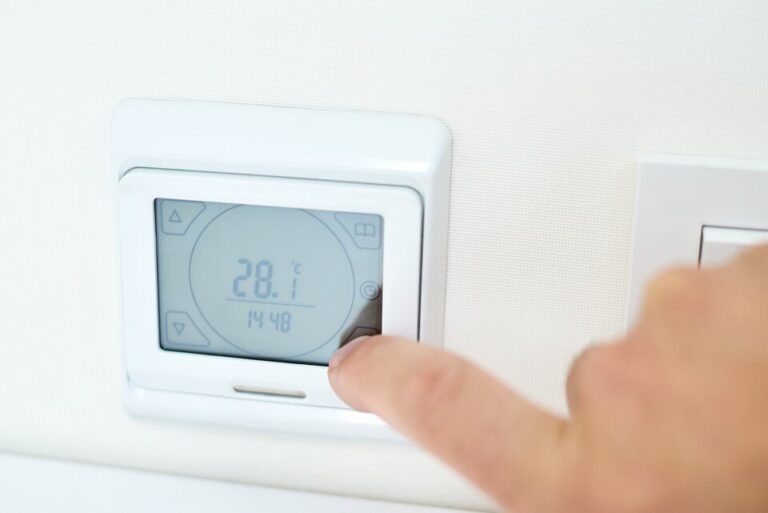When triple-digit temperatures hit Palm Springs, a working air conditioner isn’t optional—it’s a must-have. At the center of every cooling system is the thermostat. When it’s working right, you rarely have to think about it. But when your thermostat stops responding, your comfort disappears fast. The AC may blow warm air, run nonstop, or shut off completely. None of these outcomes work when you’re trying to beat the heat.
A non-responsive thermostat can bring your whole system to a halt. People often assume the problem is with the air conditioner itself, but many times, the issue is right at the wall where you adjust the temperature. The good news is that there are a few common reasons this happens, and some of them can be identified quickly. Knowing what to look for helps you avoid unnecessary stress and tells you when it’s time to get professional air conditioning repair in Palm Springs.
Common Thermostat Issues That Affect AC Performance
When the thermostat doesn’t respond or the AC isn’t running properly, it’s easy to feel stuck. But small issues are often at the root of the problem. Before thinking the entire system is broken, it’s helpful to understand what tends to go wrong with thermostats over time.
Here are a few of the most common reasons for thermostat failure:
– Dead or Low Batteries: Many thermostats rely on AA or AAA batteries. When those start to lose charge, the screen may flash, go dark, or stop sending signals to your AC.
– Unresponsive Screen or Buttons: If the display screen remains blank or none of the buttons work, there could be an internal fault, damage, or a connection issue inside the unit.
– Incorrect Settings: A thermostat that’s been accidentally set to “heat” instead of “cool” or placed on a timer cycle can make it seem broken, even though it’s following the wrong setting.
– Programming Issues: Smart or programmable thermostats often have preset modes. These can create confusion if the system isn’t following the commands you expect. Time delays, locked screens, or outdated programming may all get in the way.
If you’re noticing any of these issues, step one is recognizing the symptom. A thermostat that lights up but doesn’t activate the AC points to a different issue than a screen that’s entirely blank. For example, one Palm Springs homeowner hit a wall when their AC kept running even after they shut it off from the thermostat. It turned out the internal relay had failed, and the unit needed replacement. These problems may start small but can snowball into bigger ones if ignored too long.
Quick Thermostat Troubleshooting Steps
Before assuming your AC unit is down for good, there are a few things you can look at. Some issues may seem larger than they are, especially during the warmer months when your system is under more pressure. These steps can help pinpoint whether the problem lies in the thermostat or further down the line.
Try the following checks:
1. Check Battery Status: If your thermostat uses replaceable batteries, take them out and replace them with fresh ones. If the screen lights up again, this may be the only fix you need.
2. Confirm Power Source: Make sure the thermostat is firmly mounted to the wall base and hasn’t lost its connection. If it’s hardwired, check that the circuit breaker for the HVAC system hasn’t tripped.
3. Review Temperature Settings: Make sure the thermostat is set to “auto” or “cool” and that the temperature is set lower than the current room temp. Small changes here can make a big difference.
4. Look Over the Wiring: If you feel confident, remove the faceplate and check whether the wires are loose or disconnected. Any damage or corrosion needs to be handled by our technicians.
5. Reboot the Thermostat: Some models have a reset function, while others may require a full restart. This can clear old programming bugs or glitches without further tools.
If none of these steps help and the AC still isn’t kicking in, or the system is behaving strangely, there’s a good chance the problem is more complex. Electrical faults, shorted wires, or control board issues inside the thermostat or AC system can’t be seen from the outside. When your comfort depends on a quick fix, that’s when our professionals are ready to step in.
When to Call for Professional Air Conditioning Repair in Palm Springs
If the thermostat is still unresponsive after you’ve gone through the basic checks, it’s time to get support from our professionals. Persistent issues often point to electrical faults, aging internal components, or connection problems that require the right tools and experience to diagnose. These kinds of problems can’t be fixed safely or accurately without proper training.
You may also notice signs that something deeper is going on. Flickering screens, irregular AC cycling, or a system that runs but doesn’t cool are often related to wiring faults or sensor failures. Our technicians are trained to trace these problems back to their cause. Whether it’s corrosion on a contact point or heat damage near the circuit board, finding and resolving the issue quickly can help you avoid bigger system failures.
Here are a few signs that indicate it’s time for air conditioning repair in Palm Springs:
– The thermostat is intermittently working or cutting out.
– You’ve replaced the batteries but the screen won’t turn on.
– The AC doesn’t respond to temperature changes or mode settings.
– There’s visible damage to wires or connectors.
– The system won’t shut off or keeps restarting unexpectedly.
It doesn’t take long for broken climate control to affect your comfort, especially during warmer months. If there’s any doubt about your system’s safety or reliability, the best move is to have it looked at by our technicians. Trying to wait it out could lead to further damage or higher repair costs down the line.
Keeping Your Thermostat in Top Shape
Routine maintenance goes a long way in preventing larger issues. While a thermostat might seem like a small component, it plays a key role in how your AC functions. A unit that’s working efficiently keeps temperatures steady and helps avoid unnecessary energy use.
Simple steps like checking the batteries before peak season, cleaning dust from around the faceplate, or updating the schedule settings each spring or summer can make a difference. If you have a programmable thermostat, making sure it’s updated with your household’s current schedule keeps it from overworking the AC when no one’s home.
Having your thermostat checked during a regular AC inspection ensures there aren’t any mounting issues behind the wall. Our professionals also look for signs of overheating or wire corrosion during a service call. This helps you stay ahead of problems that tend to show up during the hottest stretch of summer in Palm Springs.
Restoring Comfort With a Working Thermostat
When your thermostat responds the way it’s supposed to, you get more than control over your AC—you get peace of mind. On the hottest afternoons, there’s no room for uncertainty about whether your cooling system will keep the house comfortable. That’s why it’s important to treat thermostat issues early, even if they seem minor at first.
A working thermostat means fewer surprises, more predictable cooling, and a system that lasts longer. If something feels off and simple adjustments aren’t doing the trick, it makes sense to have our technicians inspect the system. Fast, accurate service can save your AC from a complete breakdown and help you stay comfortable through high temperatures in Palm Springs.
When persistent thermostat issues cause your system to underperform, professional help is essential for restoring comfort in Palm Springs. Absolute Air Conditioning & Heating is here to ensure your system is promptly and effectively fixed, with expert air conditioning repair in Palm Springs tailored to your needs. For a quick estimate or to book a service visit, please contact us today.

